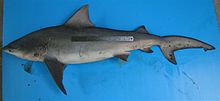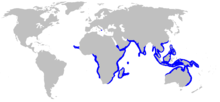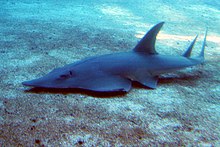Pigeye shark
| Pigeye shark | |
|---|---|

| |
| Scientific classification | |
| Domain: | Eukaryota |
| Kingdom: | Animalia |
| Phylum: | Chordata |
| Class: | Chondrichthyes |
| Subclass: | Elasmobranchii |
| Subdivision: | Selachimorpha |
| Order: | Carcharhiniformes |
| Family: | Carcharhinidae |
| Genus: | Carcharhinus |
| Species: | C. amboinensis
|
| Binomial name | |
| Carcharhinus amboinensis | |

| |
| Range of the pigeye shark[2] | |
| Synonyms | |
|
Carcharias amboinensis Müller & Henle, 1839
| |
The pigeye shark or Java shark (Carcharhinus amboinensis) is an uncommon species of requiem shark, in the family Carcharhinidae, found in the warm coastal waters of the eastern Atlantic and western Indo-Pacific. It prefers shallow, murky environments with soft bottoms, and tends to roam within a fairly localised area. With its bulky grey body, small eyes, and short, blunt snout, the pigeye shark looks almost identical to (and is often confused with) the better-known bull shark (C. leucas). The two species differ in vertebral count, the relative sizes of the dorsal fins, and other subtle traits. This shark typically reaches lengths of 1.9–2.5 m (6.2–8.2 ft).
The pigeye shark is an
presently assesses this species as vulnerable.Taxonomy

German biologists
Phylogeny and evolution
Since the pigeye shark so strongly resembles the bull shark,
Genetic analysis of pigeye sharks across northern Australia suggest that the evolutionary history of this species was affected by coastline changes during the
Description
The pigeye shark is a very robust-bodied species with a short, broad, and rounded snout. The small and circular eyes are equipped with
The first
The skin is covered by rather large
The pigeye shark can be most reliably distinguished from the bull shark by the number of precaudal (before the caudal fin) vertebrae (89–95 in C. amboinensis versus 101–123 in C. leucas). Externally, it has a greater size difference between its dorsal fins (first-to-second height ratio >3.1:1 versus ≤3.1:1 in C. leucas) and the notch in its anal fin margin forms an acute angle (versus a right angle in C. leucas). This species also usually has fewer tooth rows in the lower jaw (10–12 on each side versus 12–13 in C. leucas).[2][4]
Distribution and habitat
Though widely distributed in the
The pigeye shark inhabits coastal waters down to a depth of 150 m (490 ft), favouring environments with fine
Biology and ecology
The pigeye shark is a largely solitary animal, though occasionally several individuals may be found at the same location.
Feeding

Though the pigeye shark will take prey from anywhere in the
Life history
The pigeye shark is
Young sharks can be found in shallow
Human interactions
Large and formidably toothed, the pigeye shark is regarded as potentially dangerous to humans, though it has not been implicated in any attacks. This species is caught infrequently on
References
- ^ doi:10.2305/IUCN.UK.2021-2.RLTS.T39366A173434051.en. Retrieved 19 November 2021.)
{{cite journal}}: CS1 maint: multiple names: authors list (link - ^ ISBN 978-3-89937-132-1.
- ^ Müller, J.; Henle, F.G.J. (1839). Systematische Beschreibung der Plagiostomen. Vol. 2. Veit und Comp. p. 40.
- ^ ISBN 978-92-5-101384-7.
- ISBN 978-0-691-08453-4.
- S2CID 39697113.
- PMID 21129490.
- ISBN 978-1-4398-3924-9.
- ^ S2CID 15426537.
- ^ ISBN 978-0-674-03411-2.
- ^ McKay, R.J.; Beinssen, K. (1988). "Albinism in the pigeye whaler shark Carcharhinus amboinensis Mueller and Henle from Queensland Australia". Memoirs of the Queensland Museum. 25 (2): 463–464.
- ^ De Maddalena, A.; Della Rovere, G. (2005). "First record of the pigeye shark, Carcharhinus amboinensis (Müller & Henle, 1839), in the Mediterranean Sea" (PDF). Annales Series Historia Naturalis. 15 (2): 209–212.
- ^ .
- ^ .
- doi:10.1071/MF10136.
- S2CID 25023218.
- .
- ^ PMID 19761769.
- PMID 16019004.
- ^ Campbell, R.A.; Beveridge, I. (1987). "Floriceps minacanthus sp. nov. (Cestoda: Trypanorhyncha) from Australian fishes" (PDF). Transactions of the Royal Society of South Australia. 111 (3–4): 189–194. Archived from the original (PDF) on 2014-12-15.
- ^ Palm, H.W.; Beveridge, I. (2002). "Tentaculariid cestodes of the order Trypanorhyncha (Platyhelminthes) from the Australian region". Records of the South Australian Museum. 35 (1): 49–78.
- S2CID 18892377.
- .
- .
- ^ .
- .
- .
- doi:10.1071/MF10271.
- PMID 7725322.



